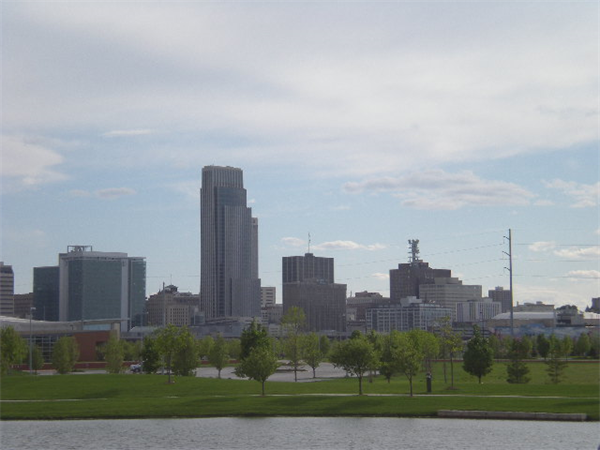- CURRENT LOCATION: HOME
- >> About Shaanxi
- >> Global Associations
- >> Sister Cities
- >>
- Shaanxi
Nebraska (U.S.A.)
2017-04-11 10:43:41 , Source : The Government Website of Shaanxi Province
Nebraska is a state that lies in both the Great Plains and the Midwestern United States. The state is bordered by South Dakota to the north, Iowa to the east and Missouri to the southeast, both across the Missouri River, Kansas to the south, Colorado to the southwest and Wyoming to the west. Its area is just over 77,220 sq mi (200,000 km2) with almost 1.9 million people. Its state capital is Lincoln. Its largest city is Omaha, which is on the Missouri River.
Indigenous peoples including Omaha, Missouria, Ponca, Pawnee, Otoe, and various branches of the Lakota (Sioux) tribes lived in the region of present-day Nebraska for thousands of years before European exploration. The state is crossed by many historic trails and was explored by the Lewis and Clark Expedition.
Nebraska was admitted as the 37th state of the United States in 1867. It is the only state in the United States whose legislature is unicameral and officially nonpartisan.
Nebraska is composed of two major land regions: the Dissected Till Plains and the Great Plains. The Dissected Till Plains is a region of gently rolling hills; the state's largest cities, Omaha and Lincoln, are in this region. The Great Plains occupy most of western Nebraska, characterized by treeless prairie, suitable for cattle-grazing. The state has a large agriculture sector and is a major producer of beef, pork, corn, and soybeans. Two major climatic zones are represented in Nebraska: the eastern half of the state has a humid continental climate (Köppen climate classification Dfa), and the western half, a semi-arid climate (Koppen BSk). The entire state has wide variations between winter and summer temperatures, and violent thunderstorms and tornadoes happen primarily during the spring and summer, though these storms can also occur in the autumn.
Geography
The state is bordered by South Dakota to the north; Iowa to the east and Missouri to the southeast, across the Missouri River; Kansas to the south; Colorado to the southwest; and Wyoming to the west. The state has 93 counties; it occupies the central portion of the Frontier Strip. Nebraska is split into two time zones, with the state's eastern half observing Central Time and the western half observing Mountain Time. Three rivers cross the state from west to east. The Platte River, formed by the confluence of the North Platte and the South Platte, runs through the state's central portion, the Niobrara River flows through the northern part, and the Republican River runs across the southern part.
Nebraska is composed of two major land regions: the Dissected Till Plains and the Great Plains. The easternmost portion of the state was scoured by Ice Age glaciers; the Dissected Till Plains were left after the glaciers retreated. The Dissected Till Plains is a region of gently rolling hills; Omaha and Lincoln are in this region. The Great Plains occupy most of western Nebraska, with the region consisting of several smaller, diverse land regions, including the Sandhills, the Pine Ridge, the Rainwater Basin, the High Plains and the Wildcat Hills. Panorama Point, at 5,424 feet (1,653 m), is Nebraska's highest point; though despite its name and elevation, it is a relatively low rise near the Colorado and Wyoming borders. A past Nebraska tourism slogan was "Where the West Begins"; locations given for the beginning of the "West" include the Missouri River, the intersection of 13th and O Streets in Lincoln (where it is marked by a red brick star), the 100th meridian, and Chimney Rock.
Economy
The Bureau of Economic Analysis estimate of Nebraska’s gross state product in 2010 was $89.8 billion. Per capita personal income in 2004 was $31,339, 25th in the nation. Nebraska has a large agriculture sector, and is a major producer of beef, pork, corn (maize), soybeans, and sorghum. Other important economic sectors include freight transport (by rail and truck), manufacturing, telecommunications, information technology, and insurance.
As of April 2015, the state's unemployment rate was 2.5%, the lowest in the nation.
Politics
For most of its history, Nebraska has been a solidly Republican state. Republicans have carried the state in all but one presidential election since 1940: the 1964 landslide election of Lyndon B. Johnson. In the 2004 presidential election, George W. Bush won the state's five electoral votes by a margin of 33 percentage points (making Nebraska's the fourth-strongest Republican vote among states) with 65.9% of the overall vote; only Thurston County, which is majority-Native American, voted for his Democratic challenger John Kerry. In 2008, the state split its electoral votes for the first time: Republican John McCain won the popular vote in Nebraska as a whole and two of its three congressional districts; the second district, which includes the city of Omaha, went for Democrat Barack Obama.
Despite the current Republican domination of Nebraska politics, the state has a long tradition of electing centrist members of both parties to state and federal office; examples include George W. Norris (who served few years in the Senate as an independent), J. James Exon, and Bob Kerrey. Voters have tilted to the right in recent years with the election of conservative Mike Johanns to the U.S. Senate and the 2006 re-election of Ben Nelson, who was considered the most conservative Democrat in the Senate until his retirement in 2013, when he was replaced by conservative Republican Deb Fischer.
Former President Gerald Ford was born in Nebraska, but moved away shortly after birth. Illinois native William Jennings Bryan represented Nebraska in Congress, served as U.S. Secretary of State under President Woodrow Wilson, and unsuccessfully ran for President three times.

Government Organizations



Other Links

Copyright@www.shaanxi.gov.cn All Rights Reserved
Registration Number:陕ICP备10004160号
